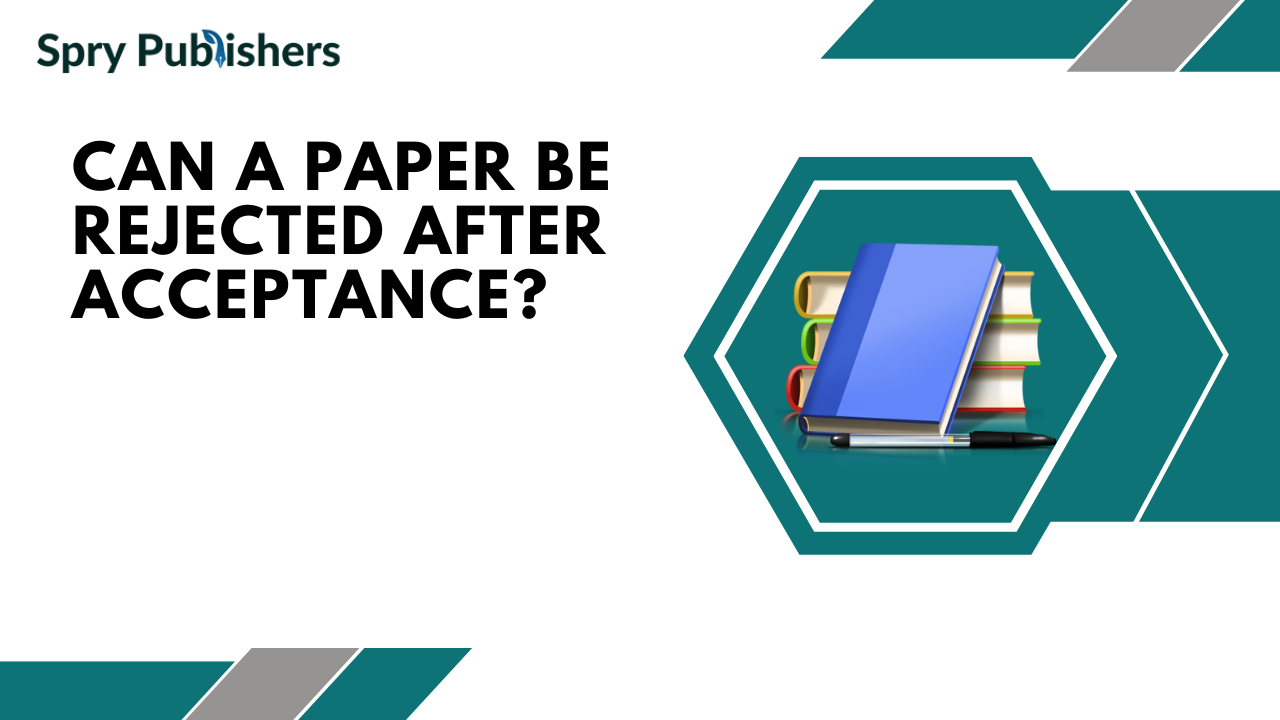Can A Paper Be Rejected After Acceptance?
- November 9, 2023
Are you thinking, “What happens after a paper is accepted? Can a paper be rejected after acceptance? After finding the perfect idea and conducting research, we understand that it is disheartening when your target journal has rejected your paper.
Publishing a research paper is often a long and rigorous journey for researchers. It begins with the inception of an idea, followed by months or even years of data collection, analysis, and writing. After overcoming numerous obstacles, the goal is to publish research in a high-indexed journal. However, a question that often arises in the minds of many researchers is, Can a paper be rejected after acceptance?
In this article, we will tell you what happens after a paper is accepted and also shed light on the possibility of rejection even after acceptance and what factors may lead to it.
What Happens After a Paper Is Accepted?
When a research paper is accepted for publication, the author(s) can breathe a sigh of relief. It shows that their hard work has met the rigorous standards of the journal’s peer-review process. However, the journey is far from over-acceptance. Here’s a glimpse into what happens after a paper is accepted.
Proofreading and Corrections
This is the last option where researchers can review their paper and correct minor errors. It’s important to proofread research carefully because poorly formatted papers can also impact negatively.
Copyright and Licensing
After the acceptance of the paper, researchers are required to sign a copyright transfer agreement with the research publisher. This legal document defines the terms of the journal about how they will distribute the research. It’s important to carefully read and understand the terms to ensure they retain the rights of their work.
Publication Schedule
After the research acceptance, publishers generally place it in a queue to determine the publication order. The length of the queue can depend on the publication frequency and number of papers accepted. However, the journal gives the estimated date of publication to the researcher.
Also Check: How to Choose PHD Research Topics
DOI Assignment
A Digital Object Identifier (DOI) is an alphanumeric string and serves as a permanent link which is used to uniquely locate an article. Before publication, journals assign DOIs to accepted papers that allow readers to cite and reference the work.
Can a Paper Be Rejected After Acceptance?
The concept of a paper being rejected after acceptance may sound perplexing to you, but it is not entirely unheard of. We know it’s heartbreaking for researchers, but there are several factors that can lead to a research rejection even after the acceptance by the journal.
Ethical Concerns
Journals may revoke the research publication if ethical concerns about research misconduct, data fabrication, or plagiarism come to light after approval.
Quality Control
If formatting errors and minor issues are found during the final proofreading and formatting stage, the paper may be rejected. To maintain quality and scientific integrity, a journal can revoke the publication.
Violation of Journal Policies
The research paper may be rejected after acceptance if a manuscript is not according to the guidelines of the journal. So, before the research paper submission, ensure it is according to the standards of the journal.
Changes in Editorial Decision
A journal’s editorial team or editorial board may change their decision due to unforeseen circumstances or an error in the initial assessment. It’s rare, but it can happen sometimes. This can also result in the reversal of an acceptance decision.
Editor’s Final Review
In a few cases, the editor-in-chief or the journal’s editorial board conduct a final review of accepted papers. This review ensures that all papers align with the journal’s standards. If issues arise during this review, the paper may be rejected.
What You Should Do If Paper Rejected After Acceptance?
If the target journal rejects your paper, don’t worry. In this case, don’t give up. There are multiple options you can consider after research paper rejection.
Appeal the Rejection
As a researcher, you have the right to appeal a rejection. It is essential to clarify any errors and address the reviewers’ comments or concerns. This information can significantly improve your article, and you can resubmit it after your edits.
Choose Another Journal
We advise you to consider the feedback from the first journal instead of appealing a rejection, make the necessary edits, and resubmit the research paper to a new journal. Hopefully, the new reviewers will find your article better suited for their publication.
Get Help From Dedicated Writing Services
The small mistakes can also lead to research paper rejection. Don’t let all your writing endeavors wreck just because of grammar and formatting errors. We suggest you hire a professional writer of your discipline to avoid rejection.
Hire a Native English Editor
A dedicated language editor can help you if you are not a native language speaker of the target journal’s language. You can ensure a smooth paper publication by getting assistance from a professional editor.
Take Professional Editing Assistance From SPRY
SPRY editing service is a comprehensive solution for authors. Generally, the editing and review of the manuscript are completed within the committed time. Get help from PhD qualified experts and take your academic journey to the next level.
Conclusion
Hopefully, you got the answers to your questions, “what happens after a paper is accepted? and can a paper be rejected after acceptance?” However, it is essential for researchers to follow ethical standards and journal guidelines. Furthermore, conducting a final review is key to mitigating the chances of rejection.
If you are looking to publish your research in a high-indexed journal, SPRY Publishers is the go-to platform for you. We offer complete research support from reviewing to submission and marketing, we keep the researcher updated. Submit your paper today and get published in the latest issue.


